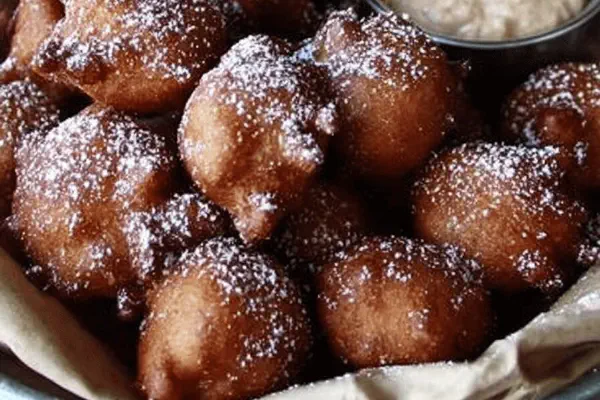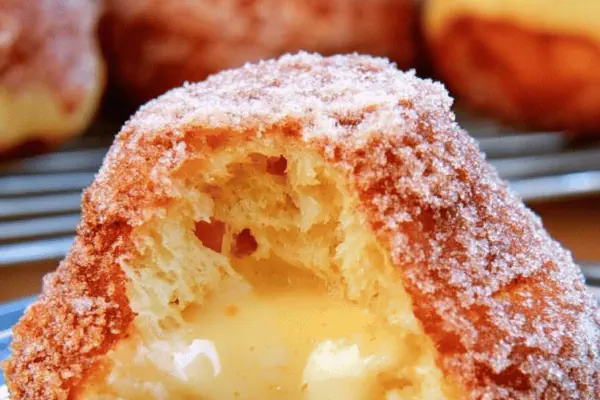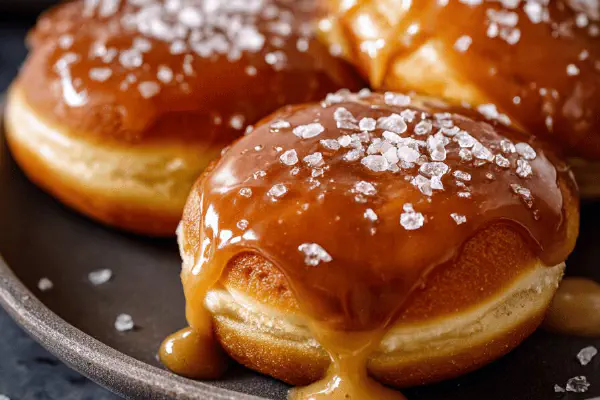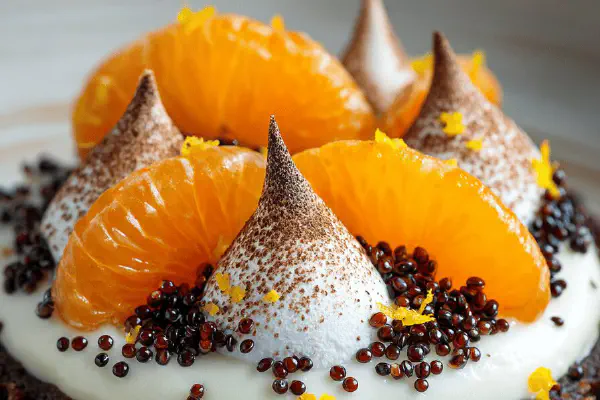Carnival Fritters Twist
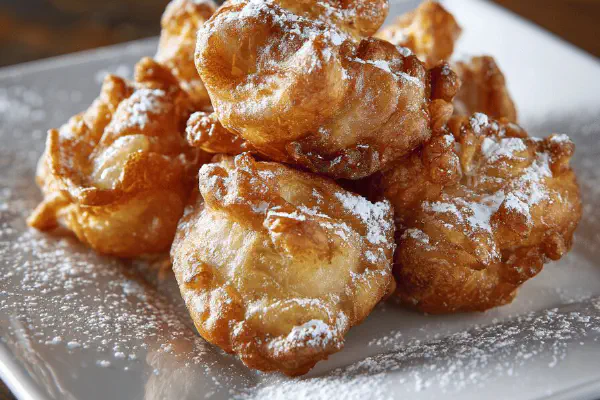
By Emma
Certified Culinary Professional
Ingredients
- 130 ml (1/2 cup plus 1 tbsp) golden raisins
- 65 ml (1/4 cup plus 1 tbsp) brandy
- 260 ml (1 cup plus 1 tbsp) warm milk
- 22 ml (4 1/2 tsp) instant yeast
- 2 large eggs
- 50 ml (3 tbsp plus 1 tsp) granulated sugar
- 1 pinch salt
- 50 ml (3 tbsp plus 1 tsp) unsalted butter melted, slightly cooled
- 740 ml (3 cups minus 2 tbsp) cake flour
- 190 ml (3/4 cup plus 1 tbsp) candied citron, diced
- 120 ml (1/2 cup) toasted almonds small pieces
- Grated zest of 1 lemon
- Olive oil for frying
COATING
- 230 ml (1 cup minus 1 tbsp) white sugar
About the ingredients
Method
NIGHT BEFORE
- 1. Toss raisins in brandy, cover. Let steep overnight at room temp or chill. Alcohol hits soften, flavor infuses; raisins plump, juicy not shriveled.
DAY OF
- 2. Dissolve yeast in warm milk (around 38°C/100°F), bubbles start quick here, active yeast smells yeasty but not sour.
- 3. Crack eggs in bowl, add sugar, salt, melted butter. Mix gently just to combine, avoid overbeat - delicate batter.
- 4. Blend egg mixture into yeast-milk gently, no whipping frenzy. Then sift in flour gradually; beat hard with wooden spoon. You'll want a sticky but cohesive dough.
- 5. Stir in soaked raisins plus brandy, candied citron, toasted almonds, lemon zest. Sharp citrus zing contrasts sweet blobs.
- 6. Now the hour-long work: fold dough with spatula or dough hook on low. The secret—lift, fold under, turn bowl clockwise. About 25-30 minutes or until dough inflates, bubbles appear under surface; dough should feel airy, slightly sticky but elastic, ready to proof.
- 7. Cover with damp cloth, proof in warm corner until doubled in size (about 1 hour). Dough soft, puffy, light to touch; poke test—dents only slowly fill back.
- 8. Heat olive oil in fryer or deep pan to 175°C (350°F). Oil hot but not smoking; test with small dough blob—it should sizzle immediately, rise to surface gently.
- 9. Spoon 30 ml (2 tbsp) dollops dough with two spoons, shape roughly roundish, slip carefully into oil – don't crowd pan. Fry 2-3 mins per side until golden intense amber, skin crisped, interior still airy, not doughy.
- 10. Drain on paper towels briefly then toss in sugar; coating sticks while fritters slightly warm but not piping hot—avoid melting sugar into clumps.
- 11. Serve warm; flaws show if cold, loses charm quickly. Crisp edges, chewy interior, rich with nuts and citrus bursts.
TIPS & SUBSTITUTES
- Use bourbon if no brandy - flavor shifts, deeper vanilla notes.
- Almonds swapped for toasted hazelnuts if preferred for more rustic crunch.
- Olive oil frying is unusual but adds fruity notes plus healthier profile. Use classic vegetable or peanut oil if drawback.
- If dough too sticky to handle, dust hands lightly but avoid excess flour; impacts final texture.
- Stirring time crucial; rote kneading omits air. Mechanical mixer with dough hook saves strength but watch speed low to avoid tearing gluten network.
- Sugar coating - vanilla sugar mix adds welcome aroma.
- Leftover fritters? Toast lightly to revive crisp or warm oven 160°C (325°F) few mins.
- Avoid over-proofing dough or fritters go overly porous, heavy, collapse in oil.
- Keep oil temp steady; too hot burns edges, raw center; too low absorbs excess oil, soggy fritters.
Cooking tips
Chef's notes
- 💡 Long folding dough—start slow after adding raisins and nuts. Lift and fold under not smash. Keep low speed if using mixer, or wooden spoon only. Air pockets develop over 25-30 minutes; feel dough elasticity. Sticky but cohesive key. If stiff, too much flour or cold environment. Resist adding flour midfold unless truly needed. Dough temperature clues—warmer means softer but tricky to handle.
- 💡 Olive oil fry temp sits at 175°C or 350°F. Use small dough blobs to test. Should sizzle immediately, rise gently. Too hot burns edges fast, undercooks inside. Crowd pan kills temp quick—fewer fritters per batch better crisp and even color. Draining on paper towel short, then sugar toss warm fritters only; hot melts sugar, cool lets it fall off. Timing critical for sugar coating to stick delicate thin layer.
- 💡 Raisins soaked in brandy overnight. Covers raisins plumpness, softens harsh bite. Alternatives like bourbon shift flavor darker, add vanilla-ish notes. Raisins shriveled? Toss soak longer or drink bourbon instead. Nuts swap toasted almonds for hazelnuts gives rustic crunch but watch bitterness from overtoast. Citrus zest fresh grated wins; dried peel loses zing. Test zest by smelling—should smell bright, not dry or bitter.
- 💡 Sugar coating - fine granulated preferred. Powdered sugar clumps and melts uneven. Sprinkle small amounts, toss fritters carefully while warm not hot. Cinnamon sugar alternative brings spice layer - mix 4:1 sugar to cinnamon. Leftover fritters? Quick oven toast 160°C few minutes restores crunch better than microwave. Cold fritters lose chew, edges soften fast; best fresh or reheated carefully.
- 💡 Proof timing counting volume, not minutes. Poke test is best - dough should dent slightly, slow bounce back. Overproofed dough loses air; fritters collapse, weigh heavy. Underproofed means dense crumb. Room temp important - cold drags proof times, warm speeds but watch overproof risk. Folding traps air but can also drain if too violent or fast. Temperature, humidity big factors here.
Common questions
How to know yeast is active?
Watch bubbles in warm milk; quick surface foam or fizz. No bubbles means dead or cold water. Smell yeasty - sour signals overworked. Retry if no rise after 10 mins. Warm milk crucial around 38°C, hotter kills yeast. I once used lukewarm, got weak rise.
Can I substitute nuts?
Yes toasted hazelnuts swap almonds for rustic crunch. Pine nuts too but pricey. Toast nuts lightly till warm and fragrant - smells release oils, adds punch. Raw ones dull. Nuts add texture contrast; skip crushing, prefer small chunks for bite. Watch bitterness from over-toasting; dark means bitter, discard.
What if dough too sticky?
Resist extra flour unless dough collapses. Sticky texture key for light fritters. Hands lightly dusted helps handling. Warm dough easier to fold. Too dry dough means flour overload or cold milk used by mistake. Adjust liquids next time or flour consistency. Mechanical mixer helps but slow speed saves gluten network; too fast tears dough, no bubbles form.
How to store leftover fritters?
Best eaten fresh. Can refrigerate airtight, but edges soften fast. Reheat in toaster oven quick few minutes revives crunch better than microwave soggy results. Freeze wrapped individually, reheat in oven. Avoid stacking to keep coating intact. Sugar coating dissolves in fridge moisture; sugar layer fragile.
